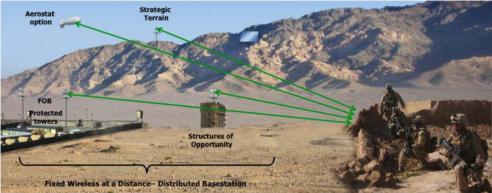BYOD – bring your own device – has swept enterprises like a firestorm as CEOs wonder why they can’t use their shiny new iPad on the corporate network, and send their IT guys and gals off to make it happen. Under the right conditions and informed use, BYOD can be a productivity boom and not mess security and privacy up too badly for many apps.
[COMMENT][/COMMENT]
In the new environment where the defense budget is a big slashing target for Congress, creative thinkers in the DoD community are putting commercial smartphones and tablets in the hands of warfighters. So far, it’s a true BYOD initiative, with small trials of a few different Android and iOS devices. But as momentum builds, and more defense types get these commercial devices in their hands, the endgame takes BYOD to a whole new level: where those people deploy, all your base stations are belong to nobody, and commercial base station technology doesn’t fit the need.
DARPA has launched an ambitious opportunity called Fixed Wireless At a Distance.They are saying they want “communications similar to our daily experience”, meaning they are looking to commercial technologies like 4G and Wi-Fi instead of only the wiz bang software defined radio binge that marked the last decade.
A critical observation behind the idea is that commercial base stations are designed to serve dense populations and limit interference. (“Hello, Lightsquared? It’s the FCC, and we’d like to talk, call us back at …”) The warfighter problem is quite different: wide geographic coverage, mobility, and ultra high connection reliability are just the start.

Reviewing their program announcement, DARPA is asking for at least three breakthroughs.
1) Distributed basestation technology that integrates multiple transmission facilities, including big towers at a forward operating base, smaller towers on strategic terrain and structures, and aerostats (blimp-based).
2) Layered range which supports 4G and Wi-Fi close in (<5km), while still supporting legacy radios at 20km and MIMO radios at 50km or more,
3) A new network architecture that doesn’t run out of bandwidth around 100 users, instead supporting 5000 users or more all with smart devices in this ad hoc network.
Notice I didn’t say “small cells” – these might be physically small and less expensive, but much greater range and network saavy is needed compared to the commercial femtocell model. These are very different problems than the “4G basestation-on-a-chip” approach from Freescale, TI, Cavium, Mindspeed, DesignArt Networks, and others are targeting for commercial networks. It’s likely silicon will be heavily reliant on FPGAs and IP cores in ASICs, since there won’t be a commercial driver for it. The building blocks of these new base stations will be the same: ARM processor cores, DSP cores from CEVA or Tensilica or others, mixed signal technology, and more.
As with almost all DARPA programs, it’s a huge stretch (wait, is that … Ace of Base I hear in the background?), but this one has a different feel of urgency since the BYOD train has already left the station and users are onboard. Those shiny new toys might as well be bricks unless something radically new is done.
FWAD Proposer’s Day is tomorrow, it’ll be interesting to see what comes forward.
Share this post via:






Facing the Quantum Nature of EUV Lithography